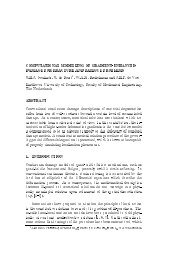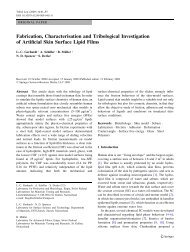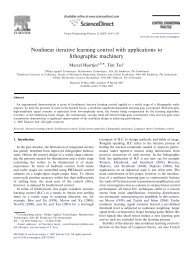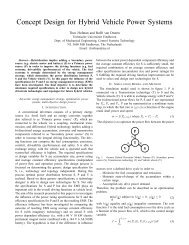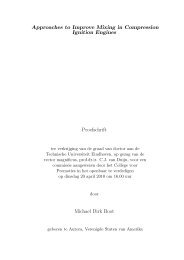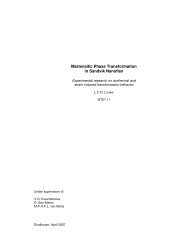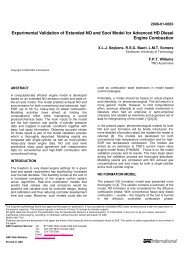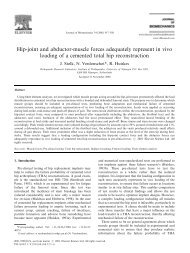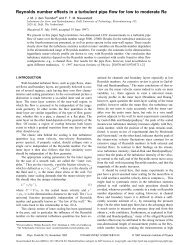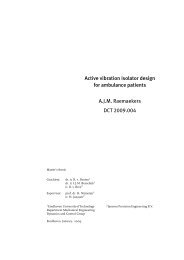Minimum gas speed in heat exchangers to avoid particulate fouling
Minimum gas speed in heat exchangers to avoid particulate fouling
Minimum gas speed in heat exchangers to avoid particulate fouling
Create successful ePaper yourself
Turn your PDF publications into a flip-book with our unique Google optimized e-Paper software.
M.S. Abd-Elhady et al. / International Journal of Heat and Mass Transfer 47 (2004) 3943–3955 3953Fig. 12. A comparison between the particle size distribution of the <strong>in</strong>jected glass particles <strong>in</strong> the airflow and the glass particles <strong>in</strong> thefirst foul<strong>in</strong>g layers deposited on the HE tube.Table 2A comparison between the particle size distribution of the <strong>in</strong>jected glass particles <strong>in</strong> the airflow and the glass particles <strong>in</strong> the first foul<strong>in</strong>glayers deposited on the HE tubea b cMean diameter (d M ) Standard deviation (SD) D 10 D 50 D 90Injected glass particles<strong>in</strong> airflowGlass particle <strong>in</strong> thefoul<strong>in</strong>g layer nearthe HE tube20.4 16.2 3.6 16.2 43.114.7 8.4 5.9 13.3 25.2All dimensions are <strong>in</strong> micrometers.a The particle diameter at which 10% of the particles are smaller than it.b The particle diameter at which 50% of the particles are smaller than it.c The particle diameter at which 90% of the particles are smaller than it.impact <strong>speed</strong> at which an <strong>in</strong>cident particle will stick <strong>to</strong>the impacted surface, i.e. V r ¼ 0, is def<strong>in</strong>ed as the criticalstick<strong>in</strong>g velocity. To show the variation of the stick<strong>in</strong>gvelocity with the <strong>in</strong>cident particle diameter the Rogersand Reed model is solved <strong>to</strong> calculate the stick<strong>in</strong>gvelocity for copper particles of diameters 10 and 4 lmhitt<strong>in</strong>g a solid steel surface. Fig. 13 shows the variationof the coefficient of restitution, e, with the impact <strong>speed</strong>,V im , for copper particles of diameters 10 and 4 lm. Thecoefficient of restitution is def<strong>in</strong>ed as the ratio betweenthe normal rebound <strong>speed</strong>, V r , and the normal impact<strong>speed</strong>, V im , for a particle hitt<strong>in</strong>g a solid surface. Fig. 13shows that if a copper particle of diameter 10 lm hits asteel surface at a <strong>speed</strong> lower than 0.025 m/s it will stick,while a copper particle of diameter 4 lm sticks if it hitsat a velocity lower than 0.12 m/s. Therefore, if we have amixture of particles of diameters 10 and 4 lm <strong>in</strong> air,which is flow<strong>in</strong>g with an average <strong>speed</strong> of 1 m/s over aHE tube, there will be a larger number of particles thathit the HE tube with a <strong>speed</strong> lower than 0.12 m/s thanthe number of particles that hits with a <strong>speed</strong> lower than0.025 m/s. This can expla<strong>in</strong> why small particles are likely<strong>to</strong> dom<strong>in</strong>ate at the beg<strong>in</strong>n<strong>in</strong>g of the foul<strong>in</strong>g process.3.4. S<strong>in</strong>ter<strong>in</strong>g of foul<strong>in</strong>g layersOnce foul<strong>in</strong>g has started and particles accumulate <strong>to</strong>build up the foul<strong>in</strong>g layer, s<strong>in</strong>ter<strong>in</strong>g takes place. S<strong>in</strong>ter<strong>in</strong>gchanges the foul<strong>in</strong>g layer structure from a weakpowdery layer <strong>to</strong> a solid stable structure strongly attached<strong>to</strong> the <strong>heat</strong> exchanger tubes [12]. S<strong>in</strong>ter<strong>in</strong>g is afunction of time and of the hot <strong>gas</strong> temperature flow<strong>in</strong>gover the foul<strong>in</strong>g layer [13]. Fig. 14 shows a cross sectionalview for a foul<strong>in</strong>g layer taken from the previousexperiments mentioned above. The particles <strong>in</strong> the layerare bronze and were subjected <strong>to</strong> hot air at 200 °C for



